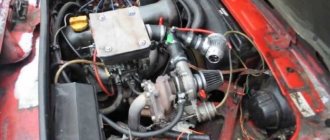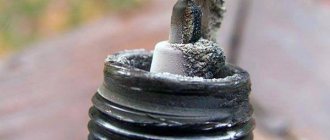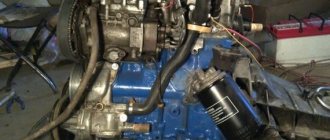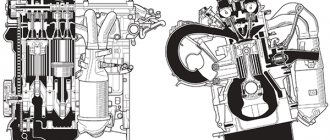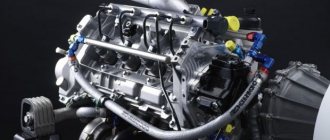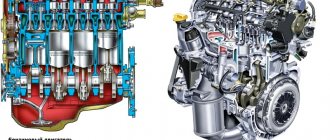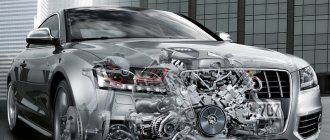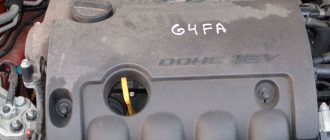Types of injection systems
The first designs of injectors only partially had electrical elements.
The majority of the design consisted of mechanical components. The latest generation of systems are already equipped with many electronic elements that ensure stable engine operation and the highest quality fuel dosage. To date, only three fuel injection systems have been developed:
- Single injection;
- Multi-injection;
- Direct injection.
Central (mono-injection) injection system
Such a system is practically never found in modern cars. It has one fuel injector, which is installed in the intake manifold, just like a carburetor. In the manifold, gasoline is mixed with air and, with the help of traction, enters the corresponding cylinder.
A carburetor engine differs from an injection engine with mono-injection only in that in the second case forced atomization is carried out. This divides the portion into more small particles. This ensures improved combustion of VTS.
However, this system has a significant drawback, which is why it quickly became outdated. Since the sprayer is mounted too far from the intake valves, the cylinders were not filled evenly. This factor significantly influenced the stability of the internal combustion engine.
Distributed (multi-injection) injection system
The multi-injection system quickly replaced the analogue mentioned above. Until now, it is considered the most optimal for gasoline engines. In it, injection is also carried out into the intake manifold, only here the number of injectors corresponds to the number of cylinders. They are installed as close as possible to the intake valves, thanks to which the chamber of each cylinder receives an air-fuel mixture with the desired composition.
The distributed injection system made it possible to reduce the “gluttony” of engines without loss of power. In addition, such cars are more compliant with environmental standards than their carburetor counterparts (and those equipped with single injection).
The only drawback of such systems is that due to the presence of a larger number of actuators, setting up and servicing the fuel system is quite complex to be done in your own garage.
Direct injection system
This is the latest development, which is used on gasoline and gas engines. As for diesel engines, this is the only type of injection that can be used in them.
In a direct fuel supply system, each cylinder has an individual injector, as in a distributed system. The only difference is that the nozzles are installed directly above the combustion chamber of the cylinder. Spraying is carried out directly into the working cavity, bypassing the valve.
This modification allows you to increase the efficiency of the engine, further reduce its consumption and make the internal combustion engine more environmentally friendly due to the high-quality combustion of the air-fuel mixture. As with the previous modification, this system has a complex structure and requires high-quality fuel.
Types and technical characteristics of injection systems
Today, only two types of injectors are considered officially used in the automotive industry:
- Electronic injector. A node of this type works strictly according to the principle described above. That is, fuel is delivered to the injectors, and then, through the use of an electronic control unit, it is correctly dosed and correctly supplied to the combustion chambers of the engine. The operation of electronic type injectors is most convenient for the trouble-free operation of any car, which is why they are used in the design of almost all modern cars;
- Mechanical injector. This same unit is deprived of head control in the form of an electronic “brain”. To be more precise, the operation of a mechanical injector is based on adjusting the fuel supply to the engine using its valves (dosage occurs by connecting the injectors to the valves with special tubes, the former, based on the degree of openness of the latter, supply the optimal amount of fuel to the engine). Units with such a device were considered some kind of innovation in the “injection” field, but in a short time they managed to prove their inconsistency and to this day are not used in the serial production of cars.
Regardless of the type of node, it is customary to highlight its main properties. Today, among the technical characteristics of the injector, it is worth highlighting one point, or rather, the method of injecting fuel into the engine. Of course, the injectors in any injection system directly inject fuel into the cylinders (intake manifold), however, the principles of gasoline delivery may differ. So, there are injectors:
- With single injection (central injection). In such systems there is only one nozzle, which supplies fuel to the engine. Today, single injection injectors are not used, so there is no need to focus on them;
- With distributed injection - the most used at the moment. Their design assumes that the injector consists of the nth number of injectors that supply fuel to each individual cylinder. Among injection systems with distributed injection, there are several subtypes, or more precisely: direct injection (often called direct) - fuel enters the combustion chamber directly;
- simultaneous injection - fuel is supplied synchronously by all injectors to each engine cylinder;
- pair-parallel injection - fuel is supplied according to a paired scheme of nozzle operation (that is, one pump works for “intake”, the other works for “exhaust”);
- phased injection - gasoline is supplied exclusively to the “inlet” in any operating mode.
It is worth noting that such a wide variety of injectors is only partly justified, since in the vast majority of cases systems with either direct or simultaneous injection types are used.
What is an injector in simple words
5th generation gas pump, design, principle of operation, advantages and disadvantages.
There are two ways to supply fuel to the cylinder:
- Pull it in using the vacuum that occurs during the suction stroke of a four-stroke engine, while simultaneously spraying it in the air stream rushing past the diffuser nozzle;
- Inject under external pressure generated by a separate pump through the fuel injector nozzle.
All carburetors operate on the first principle, and the second is the basis of injection systems.
History of appearance
The first injection systems appeared back in the century before last, approximately simultaneously with carburetors. At the same time they were patented. The engineers immediately realized that if they measured the mass of incoming air, they could accurately dose the amount of gasoline by injecting it under pressure. But the development of technology did not allow the widespread introduction of components in this direction into production cars.
Carburetors were incomparably simpler and more reliable, and most importantly - cheaper. Their other shortcomings were not very important, so all engines were equipped exclusively with carburetors.
Aviation designers were the first to confront the fundamental shortcomings of carburetors. The planes experienced overload in all directions, fuel arrived irregularly, and engines worked intermittently. Therefore, by the beginning of the Second World War, injection systems on fighter aircraft began to gradually replace carburetors.
Fuel injectors worked equally stably in any spatial orientation of the aircraft and under any overloads. This development stopped only with the end of the use of piston engines in aviation and the transition to jet propulsion.
Around the same time, racing car designers also paid attention to the advantages of injection. Here the task was to maximize engine power, which the injectors handled much better
As often happens in the development of automotive technology, new fuel systems began to gradually move to civilian production vehicles.
Immediately after the war, many specialized companies began developing injectors; their works were purchased and developed by large enterprises, as a result of which the basic types and operating principles of injection devices were formed.
The best products were components and assemblies from Bosch. First purely mechanical K-Jetronic, and then with the introduction of electronic components KE-Jetronic. It was electronics that made it possible to completely solve all problems and shape the appearance of a modern gasoline injection system.
Location, classification and marking of injectors
Design and principle of operation of a turbocharger
After analyzing the question of how the injector works, let’s look superficially at the entire injection system. The injection system injects fuel into the intake manifold and engine cylinder through a nozzle that can open and close many times in a second. The system is divided into two types. The classification depends on the location of the nozzle mounting, the way it works and the quantity:
- Mono-injection, otherwise known as central fuel injection Throttle body injection (TBI), works through a single nozzle that supplies fuel to the engine cylinders. The jet supply is not synchronized with the opening time of the engine intake valve. Single point injection is simple and contains little control electronics. The entire TBI system is located inside the intake manifold. The technology is not popular today and is almost not used in car production, as it does not meet current requirements.
- Distributive fuel injection Multiport Fuel Injection (MFI) is in demand today because it is much more advanced. Its essence is that each injector supplies fuel individually to each cylinder. The structure is attached to the outside of the intake manifold. The signals are synchronized with the engine ignition sequence. This type of injection is more complex in design, however, it is 7–10% more powerful and more economical than its predecessors.
Comparison of carburetor and injector
There are several classifications of distributor injection:
- simultaneous - the operation of all injectors is synchronous, that is, injection goes to all cylinders at once;
- pair-parallel - when one opens before the inlet, and the other before the outlet;
- phased or two-stage mode - the injector opens only before the intake. Makes it possible to increase engine torque at low speeds when pressing the accelerator pedal sharply. The injection takes place in two stages.
- direct (injection on the intake stroke) GDI (Gasoline Direct Injection) - the jet goes directly into the combustion chamber. Motors with such injection also require higher quality fuel, which contains a small amount of sulfur and other chemical elements. The GDI engine is capable of functioning properly in the combustion mode of an ultra-lean air-fuel mixture. The lower air content makes the composition less flammable. The fuel inside the cylinder arrives as a cloud, staying next to the spark plugs. The mixture is similar to the stoichiometric composition, which is highly flammable.
Injection nozzles have different methods of jet delivery:
- Electrohydraulic. It works through the difference in diesel pressure on the piston and injector. When the valve is de-energized, the nozzle needle is pressed against the seat by the liquid. And if the valve opens, then the throttle also opens, after which the fuel line is filled with diesel. During this, the pressure on the piston decreases, but nothing happens on the needle, which raises it at the moment of injection.
Injector device
- Electromagnetic. An electrical discharge controlled by the ECU is supplied to the valve winding. As a result, an electromagnetic field arises along with the squeezing of a spring. The field attracts the needle and releases the nozzle to supply the jet. The spring returns to its previous position after the electromagnetic field dissipates, sending the needle into place.
- Piezoelectric. The most advanced type, used in diesel units. Its speed of action is four times higher than previous types; in addition, the amount of injected fuel is adjusted to the maximum. The actions of the injector are based on the principle of hydraulics; work is carried out due to pressure differences. First, the needle is on the seat, then the current stretches the piezoelectric element, which begins to act on the pusher, which opens the valve to allow fuel to move into the line. Then the pressure drops and the needle rises, injecting upward.
Single Point fuel injection
Single-point injection, better known as mono-injection, is a transition technology that has allowed many automakers to cheaply switch from a carbureted power system to fuel injection.
In other words, instead of a carburetor, a central fuel injection unit began to be installed above the intake manifold. The system had a number of advantages, since the ECU made it possible to dose gasoline more accurately.
The operating principle of the injector is based on the following elements:
- – a fuel tank with a fuel pump located in it;
- – filter element for fuel purification;
- – central injection unit. 3a – throttle position sensor (TPS); 3b – regulator responsible for fuel pressure; 3с – injector nozzle; 3d – sensor of air temperature entering the intake manifold; 3e – throttle position regulator (in the simplest design options, the damper drive was connected to the accelerator pedal by a cable drive);
- – coolant temperature sensor (DTOZH);
- – lambda probe (oxygen sensor);
- – electronic engine control unit.
Principle of operation
The diagram does not show one element, without which the operation of the mechanism would be impossible - the crankshaft position sensor. It is the DPKV that allows the ECU to calculate the amount of air entering the engine. Let us recall that the amount of fuel supplied depends entirely on the mass of air entering the cylinders, otherwise it is impossible to regulate the composition of the air-fuel mixture (AFM) for normal operation of a gasoline engine. At the stage of engine creation, designers calculate how much air flows at a certain load, that is, the degree of throttle opening, and at certain engine speeds. The data is entered into the engine fuel map, which will be recorded in the ECU. Subsequently, when the engine is running, the control unit records the speed using the DPKV, the load is determined by the throttle potentiometer, which allows you to take the value corresponding to the required amount of fuel from the fuel map. But the system can ideally work only in laboratory conditions, since in practice atmospheric pressure depends not only on the position above sea level, but also on temperature; the air filter becomes clogged over time, allowing less air to pass through it, and the throttle assembly itself becomes clogged. An air temperature sensor is used for correction, but its role is small. The composition of the mixture is truly influenced by the lambda probe, which measures the amount of oxygen in the exhaust gases. If there is too much oxygen, the ECU understands that the mixture needs to be enriched, and vice versa.
Characteristic
The main advantage of single-point injection is its low cost of implementation. Flaws:
- uneven filling of the cylinders, which is due to the location of the nozzle;
- "wet" collector. When the injector opens, gasoline travels a long way to the combustion chamber. When the collector is cold, the fuel does not evaporate, but settles on the walls, as a result of which the mixture must be very rich;
- Although the lambda probe makes it possible to adjust the air pressure control system, the method of measuring air mass is generally ineffective.
Types of injection systems
Design and principle of operation of an internal combustion engine
Despite the fairly simple description of the operation of an injection engine given earlier, there are several varieties that implement a similar principle of operation.
Single point injection
This is the simplest version of the injection principle. It is practically compatible with any carburetor engine, the difference being the use of injection instead of a carburetor. If the carburetor supplies fuel assemblies to the intake manifold, then with single-point injection gasoline is injected into the intake manifold through an injector.
As in the case of a carburetor engine, during the intake stroke the engine sucks in a ready-made fuel-air mixture, and its operation is practically no different from the operation of a conventional engine. The advantage of such a motor will be better efficiency.
Multipoint injection
Represents a further stage in the improvement of injection engines. According to signals from the controller, fuel is supplied to each cylinder, but also to the intake manifold, i.e. The fuel assembly is prepared outside the cylinder and enters the cylinder in finished form. In this embodiment of the injection engine principle, it is possible to provide many of the advantages inherent in the injection engine and noted earlier.
Direct injection
It is the next stage in the development of injection engines. Fuel is injected directly into the combustion chamber, which ensures the best efficiency of the internal combustion engine. The result of this approach is obtaining maximum power, minimum fuel consumption and the best environmental safety indicators.
The injection internal combustion engine is the next stage in the development of a gasoline engine, significantly improving its performance. In engines using a fuel injection system, power increases, as well as the economic efficiency of their operation; they have a significantly less negative impact on the environment.
I like1I don't like
Types of system
The fuel injection system gets its name from the device that is responsible for spraying gasoline - the injector (from the English Injection - injection, injector - nozzle). A power system of this type was installed on aircraft back in the 20s of the last century. What is noteworthy is that even then it was direct fuel injection into the engine cylinders. We will focus on the development of variations of the Motronic system, in which the engine control unit (hereinafter referred to as the ECU or ECU) is responsible for supplying fuel and adjusting the ignition angle.
Advantages and disadvantages
Injection systems have now completely replaced carburetors, so they have virtually no disadvantages left. Rather, the dispute is between the directions of direct injection into the cylinder and multipoint injection into the intake manifold.
The advantages of the injector are undeniable and are manifested in almost everything:
- environmental requirements cannot be met by any other power system;
- complete combustion of fuel ensures maximum efficiency; it is not possible to achieve the ideal only because of conflicting requirements for economy and ecology;
- power and type of speed characteristics, that is, the curve of the dependence of torque on revolutions, can be set in the engine model, that is, in software form, especially for turbocharged engines;
- engine control can be fully automated; previously unusual functions such as turning off some cylinders, a start-stop system, and integration with an anti-theft system are available.
Some complexity of the system caused concern in the first stages of its implementation. Now the automotive world is so accustomed to the injector that it causes no more concern than household gadgets like mobile phones, which are actually much more complex.
Typical faults
The complex and multi-component design is both an advantage and a disadvantage of the injection system. Some elements may break over time and if used incorrectly, their performance is impaired, which leads to the need for repair work.
The injector is designed to burn fuel as efficiently as possible. This was made possible thanks to electronic control, which determines the optimal composition of the mixture consisting of fuel and oxygen.
There are several of the most common malfunctions that occur in the operation of the injector on modern cars.
- Damage or malfunction of the sensors. Regardless of which sensor is damaged, the overall balance in the operation of the entire fuel injection system is disrupted. This situation leads to the appearance of floating speed while driving and at idle speed. Also, the engine does not start or the engine stalls. All this is due to the fact that air and fuel are mixed in incorrect proportions. This can often be noticed by the changed color of the exhaust. Sometimes a sensor failure causes the engine to go into emergency operation mode. As a result, the speed cannot be gained, and the corresponding lamp lights up on the dashboard.
- Filters or nozzles are dirty. Another common situation that occurs mainly through the fault of the car owner himself. A similar malfunction is relevant for injection machines that are filled with low-quality fuel. Impurities and various debris in the fuel clog the filter, and in the future the injectors themselves may become dirty. If they become clogged, the shape of the spray pattern is disrupted. This leads to a local increase in temperature, detonation and valve burnout. To prevent this situation, the filter must be periodically replaced. Additionally, it is worth changing the filter mesh on the fuel pump when the mileage exceeds 70 thousand kilometers, and also wash the fuel tank once every 3-4 years.
- Fuel injectors pouring. This happens because the injectors do not close after the supply of pulses from the electronic control unit stops. As a result, some of the fuel penetrates into the combustion chamber, into the engine lubrication system, seeping through the piston rings. This leads to dire consequences for the entire engine. After all, fuel mixes with oil, and lubrication characteristics are significantly reduced. If fuel ends up in the exhaust system, the catalyst designed to clean the exhaust from harmful impurities breaks down.
- Fuel pump failure. The pressure in it may drop below the standards established by the automaker. The reasons for the breakdown are different, but mostly it is pollution. This reduces the performance of the injectors themselves.
The most important procedure that car owners of injection cars often carry out with their own hands is cleaning the injectors. Clean them by removing them or directly on the power plant
Engine flushing involves the use of special flushing compounds. They are poured into the engine and pumped through the system. In this case, the fuel line should be disconnected from the ramp, and a compressor should be installed in place of the fuel pump. It is with its help that a special flush intended for injectors is pumped throughout the system.
Another option involves removing the nozzles and using an ultrasonic bath on a stand. But this is only available in specialized car services. It is almost impossible to implement such washing in a garage.
The essence of an ultrasonic bath is that a special device uses wave vibrations to influence accumulated deposits and destroy them.
https://youtube.com/watch?v=XhSyHJkh4xg
Possible faults
The injector brings efficiency to the operation of the power plant, helps save gasoline, and helps make exhaust gases cleaner. But if the injectors start to clog, then:
- engine speed decreases;
- ignition is difficult;
- acceleration occurs more slowly;
- fuel consumption increases;
- the level of harmful components in the exhaust increases.
Modern vehicles have electrical sensors that provide information to the dashboard monitor so that the driver has the opportunity to clarify the malfunction that needs to be eliminated.
Clogging of the device can be caused by gasoline, which contains paraffin particles and complex chemical compounds. When the engine is turned off, some fuel remains in the injector. The temperature causes it to evaporate and the paraffin hardens. This creates the main obstacle to the supply of fuel. To restore normal operation, the device should be cleaned. You can use a compressor device and a special flushing liquid. The compressor is installed instead of the fuel supply pump and begins to supply solvent to the system. The duration of the procedure will depend on how severe the contamination of the injectors is. If the result is not achieved, a more drastic method should be used. To clarify the effectiveness of cleaning, you should perform an exhaust gas analysis, check the engine power and the level of pressure drop in the injector. If everything is normal, then the cleaning was successful.
The second method is more complicated and requires special skills. You will have to disassemble the engine and some components of the machine. It is recommended not to bring the device to this state. Some drivers believe that a monoinjector will be more effective. The issue is controversial; fuel consumption is not affected. A slight improvement can be obtained if you simultaneously carry out chip tuning.
System design
The injector design is simple, although the operation of the system is quite complex. Essential elements:
ECU;
nozzles;
pressure regulators;
electric fuel pump.
The electronic control unit is designed to control the operation of the system. With its help, the driver can ensure continuous operation of the injector. Injectors are an important part of the system. It is the injectors that dose the fuel and transfer it to the combustion chamber. It is recommended to clean them of gasoline or diesel residues every 30,000 km driven by car. Pressure regulators stabilize the operation of the injector. With their help, fuel is pushed through the nozzles into the combustion chamber.
An electric fuel pump supplies gasoline to the engine. It serves as a link between the engine and the gas tank, which are located at different ends of the car. For mechanical injectors, older cars used mechanical fuel pumps. They have less efficiency and a shorter service life.
The injector device also includes sensors. They show the heating temperature and the amount of oil, the voltage in the engine.
Depending on the type of injector, its structure also changes. The electromagnetic injector consists of an armature and nozzle, a needle, a seal, a spring, an excitation winding and an electromagnetic connector, as well as a strainer. These parts are combined into a single system under a common body.
The electrohydraulic injector does not have a strainer. But it contains other parts: a control chamber, a gasoline supply fitting, a drain throttle, a piston. It is they who ensure the dosed supply of fuel to the combustion chamber.
A piezoelectric injector has all these components, but there are also additional parts. These include: discharge channel, switching valve. They ensure stable operation of the system.
Regardless of the type of injector, its functioning does not change. It is based on the same operating principles.
GDI engine operating modes
There are three engine operating modes in total:
- Ultra-lean mixture combustion mode (fuel injection on the compression stroke).
- Power mode (injection on the intake stroke).
- Two-stage mode (injection on the intake and compression strokes) (used on European modifications).
Ultra-lean mixture combustion mode (fuel injection on the compression stroke). This mode is used under light loads: during quiet city driving and when driving outside the city at a constant speed (up to 120 km/h). The fuel is injected in a compact spray at the end of the compression stroke in the direction of the piston, reflected from it, mixed with air and evaporated, heading towards the spark plug area. Although the mixture in the main volume of the combustion chamber is extremely lean, the charge in the spark plug area is rich enough to ignite with a spark and ignite the rest of the mixture. As a result, the engine operates stably even with an overall air to fuel ratio of 40:1 in the cylinder.
Running the engine on a very lean mixture posed a new problem - exhaust gas neutralization. The fact is that in this mode, the majority of them are nitrogen oxides, and therefore a conventional catalytic converter becomes ineffective. To solve this problem, exhaust gas recirculation (EGR-Exhaust Gas Recirculation) was used, which sharply reduces the amount of nitrogen oxides formed and an additional NO catalyst was installed.
The EGR system, by “diluting” the fuel-air mixture with exhaust gases, reduces the combustion temperature in the combustion chamber, thereby “muffling” the active formation of harmful oxides, including NOx. However, it is impossible to ensure complete and stable neutralization of NOx only through EGR, since as the load on the engine increases, the amount of bypassed exhaust gas must be reduced. Therefore, a NO catalyst was introduced into the direct injection engine. There are two types of catalysts for reducing NOx emissions - selective (Selective Reduction Type) and storage type (NOx Trap Type). Storage-type catalysts are more efficient, but are extremely sensitive to high-sulfur fuels, to which selective ones are less susceptible. In accordance with this, storage catalysts are installed on models for countries with low sulfur content in gasoline, and selective catalysts for the rest.
Power mode (injection on the intake stroke). The so-called “uniform mixture formation mode” is used for intense city driving, high-speed suburban traffic and overtaking. Fuel is injected during the intake stroke with a conical spray, mixing with air and forming a homogeneous mixture, as in a conventional engine with distributed injection. The composition of the mixture is close to stoichiometric (14.7:1)
Two-stage mode (injection on intake and compression strokes). This mode allows you to increase engine torque when the driver, moving at low speeds, sharply presses the accelerator pedal. When the engine is running at low speeds and is suddenly supplied with a rich mixture, the likelihood of detonation increases. Therefore, injection is carried out in two stages. A small amount of fuel is injected into the cylinder during the intake stroke and cools the air in the cylinder. In this case, the cylinder is filled with an ultra-lean mixture (approximately 60:1), in which detonation processes do not occur. Then, at the end of the compression stroke, a compact jet of fuel is delivered, which brings the air-to-fuel ratio in the cylinder to a rich 12:1.
Why is this regime introduced only for cars for the European market? Yes, because Japan is characterized by low speeds and constant traffic jams, while Europe has long highways and high speeds (and therefore high engine loads).
Mitsubishi pioneered the use of direct fuel injection. Today, similar technology is used by Mercedes (CGI), BMW (HPI), Volkswagen (FSI, TFSI, TSI) and Toyota (JIS). The main principle of operation of these power systems is similar - the supply of gasoline not into the intake tract, but directly into the combustion chamber and the formation of layer-by-layer or homogeneous mixture formation in various engine operating modes. But such fuel systems also have differences, sometimes quite significant. The main ones are the operating pressure in the fuel system, the location of the injectors and their design.
The principle of operation of the injector and its design
I think it will be best if we consider the principle of operation of the injector on a distributed injection system, since it is this system that is installed on most cars and is considered one of the most successful and widespread.
For convenience, I propose to divide the fuel supply system into two main components - electronic and mechanical. The role of the mechanical system is quite simple - ensuring a continuous and dosed supply of fuel to the cylinders. But the system is controlled and monitored electronically.
Mechanical part
The mechanical component of the injection system includes the following components:
- fuel pump (electric);
- fuel tank;
- gasoline purification filter;
- fuel rail;
- high pressure fuel lines;
- nozzles;
- throttle assembly;
- air filter.
This list of components is not exhaustive. Depending on the design features of the engine and control system, other elements may be included in the mechanical part. The above list is a list of must-have items for any engine.
https://www.youtube.com/watch?v=XhSyHJkh4xg
Principle of operation
Now let's look at why all these components are needed and what work each of them does. I think everyone already knows that a fuel tank is a container for gasoline. The electric fuel pump, which is located in the tank, ensures a continuous supply of fuel under pressure.
After which the fuel enters the filter, where it is cleaned of impurities and other debris. High pressure fuel lines allow gasoline to move freely through the fuel supply system.
The pressure regulator does not allow the critical pressure level to be reached throughout the entire system. Through the regulator, the fuel enters the fuel frame, which supplies it to the injectors. The injectors are located in the intake manifold.
A few years ago, injectors were triggered by fuel pressure and their design was completely mechanical. Here the principle of operation is quite simple - gasoline puts pressure on the injector spring and opens it, and through it it is injected into the cylinders.
Nowadays, most cars have electromagnetic injectors. The main component, which is a regular armature and winding. The fuel supply channel opens by receiving a signal from the electronic control system.
On the reverse side, air is forced into the system through an air filter. The throttle assembly with a damper is located in the pipe through which air flows. When the driver presses the gas pedal, he acts on the throttle. But the driver only controls the air that is supplied to the cylinder; the fuel is regulated by an electronic control system.
Electronic part
The memory unit and controller are the main components in the electronic control system, which in turn serves as the basis of the electronic part of the injection system. The control unit controls the fuel supply system thanks to a number of sensors that are included in the injector design.
The main sensors that provide the electronic control unit with information about the operation of the fuel system are:
- Lambda probe.
The task of this sensor is to determine the remaining air in the exhaust gases. Based on the data received, the control unit regulates the air supply to the fuel mixture. - Mass air flow sensor.
The job of this sensor is to determine the volume of air that passes through the throttle valve. Typically this sensor is installed inside the air filter housing. - Throttle position sensor.
Giving a signal about the position of the gas pedal is the main purpose of this sensor. - Power plant temperature sensor.
Depending on the engine temperature reported by this sensor, the control unit regulates the fuel mixture. - Crankshaft position sensor.
This sensor is responsible for selecting the cylinder into which fuel must be supplied and the timing of the spark. - Knock sensor.
It is located in the cylinder block and is designed to detect and eliminate detonations. - Speed sensor.
Creates impulses, thanks to which the speed of the vehicle is calculated. The fuel mixture is adjusted based on the readings from it. - Phase sensor.
It determines the angular position of the camshaft.
Car injector: how it works and how it works
Hello, dear car enthusiasts! Just as “the iron horse replaced the country horse,” the fuel injection system also replaced carburetors in cars.
Let experts argue about the advantages and disadvantages of fuel supply systems, but the car owner’s task is to have an idea of what an injector is and how a car’s injector works.
And you don’t necessarily need the device and operating principle of the injector in order to repair it yourself. But you need to know how a car injector works and what it consists of. At least so that unscrupulous car service technicians do not try to “warm up” their hands on your ignorance of your car.
Injector as a revolution in the automotive industry
What is a car injector? An injector (Latin injicio, French Injecteur, English Injector - I throw it away) is a nozzle, like a gas or liquid (fuel) atomizer in engines, or part of an injection system for supplying (injecting) fuel in internal combustion engines.
The year of birth of the injection system is considered to be 1951, when Bosch equipped the 2-stroke engine of the Goliath 700 Sport coupe with it. Then, in 1954, the Mercedes-Benz 300 SL picked up the baton.
Massive, serial introduction of fuel injection systems began in the late 70s of the last century. The operation of the injector, in its operational characteristics, was in many ways superior to the operation of the carburetor fuel supply.
As a result: the first decade of the 21st century has practically completed the displacement of carburetors. Modern cars are mainly equipped with distributed and direct electronic injection systems.
The principle of operation of the injector in the fuel supply system
Fuel Injection System (fuel injection system) supplies fuel through direct injection using a nozzle (injector) into the engine cylinder or into the intake manifold. Accordingly, cars equipped with such a system are called injection cars.
The classification of injection injection depends on the principle of operation of the injector, as well as on the location of installation and the number of injectors.
Central fuel injection (mono-injection) injects all engine cylinders using one injector. The injector is usually located on the intake manifold (in place of the carburetor). The mono-injection system is not popular among automakers today.
The bulk of modern production cars are equipped with a distributed fuel injection system. That is, a separate injector is responsible for its own cylinder.
The distributed fuel injection system is classified by type:
- simultaneous - all injectors of the system supply fuel simultaneously to all cylinders,
- pair-parallel - a type of injection when the injectors open in pairs: one opens before the intake cycle, the other before the exhaust cycle. It is characteristic that the pair-parallel principle of opening the injectors is used during engine startup, or in emergency mode when the camshaft position sensor malfunctions. And while driving, the so-called phased fuel injection is used,
- phased - type of injection when each injector opens before the intake stroke,
- direct - a type of injection that occurs directly into the combustion chamber.
The principle of operation of the injector is based on the use of signals from a microcontroller, which in turn receives data from sensors.
Injector operation diagram
If you don’t get into the jungle of the “electronic brain” of our car, then the injector operation diagram looks like this. Numerous sensors receive information about: crankshaft rotation, air flow, engine coolant temperature, throttle valve, engine detonation, fuel consumption, speed limit, vehicle on-board voltage, and so on.
The controller, receiving this information about the vehicle parameters, controls systems and devices, in particular: fuel supply, ignition system, idle speed control, diagnostic system, and so on. The change in operating parameters of the injection injection system changes systematically, based on the data obtained.
The device of a simple injector
The injector includes such actuators as:
- fuel pump (electric),
- ECU (controller),
- pressure regulator,
- sensors,
- nozzle (injector).
Accordingly, the injector circuit: an electric fuel pump supplies fuel, a pressure regulator maintains the pressure difference in the injectors (nozzles) and the air in the intake manifold. The controller processes information from sensors: temperature, detonation, camshaft and crankshaft, and controls ignition systems, fuel supply, and so on.
The fuel injection system is good for everyone, but it is not without its own characteristics. Adherents of carburetors call them disadvantages. The features of the injector can be safely named: the fairly high cost of the injector components, low maintainability, high requirements for the quality and composition of the fuel, the need for special equipment for diagnostics, and the high cost of repair work.
Now, let's move on from the story about how the injector works and looks like to a visual aid. You will see in the video the principle of operation of the injector, and everything that is written above will immediately become clear to you.
Actuators
The actuators got their name because they make adjustments to the operation of the engine. That is, the control unit receives a signal from the sensor, analyzes it, and then sends the signal to the actuator.
Fuel pump
Let's start with the power system. It is installed in the tank and supplies fuel to the fuel rail at a pressure of 3.2 - 3.5 MPa. This ensures high-quality fuel spray into the cylinders. As soon as the engine speed increases, the appetite also increases, which means more fuel must be supplied to the ramp to maintain pressure. The pump begins to rotate faster at the command of the control unit. Most modern cars, starting around 2013, are equipped with a fuel module, which includes a pump and a built-in filter. This significantly affects the cost of filter replacement, because the entire module must be replaced. Some manufacturers write in the instructions that the module is installed for the entire service life of the car, but you should not believe that any filter can last more than 2 seasons.
Nozzle
After the fuel has passed the entire circuit of the wire, it enters the nozzle, which meters its supply into the cylinder. The injector is a very small diameter solenoid valve that sprays gasoline into the combustion chamber. The ECU modifies the amount of fuel supplied by time intervals while the injector is open. As a rule, this is tenths of a second.
Idle air control (IAC)
This is also an electromagnetic valve, the rod of which closes the air duct that bypasses the throttle valve. Depending on the voltage that the control unit supplies to it, it opens this very channel.
Ignition module
In principle, this is the same ignition coil, only there are four of them. When current passes through the primary winding, a high-frequency high-voltage current is switched into the secondary winding, which is supplied to the spark plug.
Design and principle of operation
To understand in more detail the principle of operation of the injector, you need to look at its main components. Any injection system consists of several basic elements. Namely from:
- fuel injectors,
- fuel rail,
- pump,
- sensors,
- ECU.
Each component plays a key role in how the injector operates with the fuel delivery injectors installed inside it.
- Injectors. They are the main, main element of the entire supply system. It is the injectors that give rise to the name injector, since they are designed to spray and deliver fuel through special intake manifolds or directly into the combustion chamber of fuel. An injector consists of a body with a valve inside. This valve is necessarily of the solenoid type. It opens and closes the sprayer (nozzle). The spraying process itself is carried out due to the presence of a ring-shaped hole provided between the needle and the walls of the housing. The needle is controlled by a valve.
- Ramp. An important element for modern automotive injection systems that operate on the principle of distributed injection. Using a ramp, fuel is supplied to all installed injectors and combines them into a common system.
- Pump. Since fuel in the case of injectors is supplied under a certain pressure, an electric pump is needed to create it.
- ECU. The control unit is fully responsible for the control and supply process of the formed air-fuel mixture. Outwardly it resembles a small block connected to various sensors, injectors, a fuel pump, as well as an ignition system and other elements. The ECU collects information from various controllers and sensors, which allows it to correctly determine the proportions of fuel and air, perform injection at the right time, etc.
- Sensors Using sensors, various indicators are recorded in real time. Moreover, each automaker determines the list of sensors to which the ECU is connected. The more information the controllers transmit to the control unit, the more efficiently the entire system operates.
All these components are closely related to each other and constantly interact. It is on this interaction that the operating principle of the injection engine itself is based.
It looks something like this:
- the ignition is turned on,
- power goes to the pump located in the fuel tank,
- the pump transfers fuel through the line under pressure,
- the injectors are located on the rail,
- fuel flows through the rail to the injector,
- Additionally, pressure regulators are located on the rack (ramp),
- sensors transmit information necessary for analysis to the computer,
- the unit synchronizes injection by supplying special control pulses to the injectors,
- impulses force the working injectors to open at a given point in time.
In simple terms, fuel is sprayed using working nozzles in the manifold itself, mixed there with oxygen (air) and supplied to the combustion chamber through valves.
An undeniable advantage of a modern fuel injection system is the ability to automatically change the engine operating mode in a split second, based on current conditions.
Such high precision in the operation of the system was made possible through the use of electronics integrated into the control unit of the entire car engine.
Each sensor continuously transmits information to the ECU, which analyzes it and adjusts the operation of the system as necessary. This allows you to achieve the required power, performance, efficiency and environmental friendliness.
Operating principle of the injector
The simplest injector has the following elements in its design:
- Electronic control unit;
- Gasoline pump (electric);
- Injectors;
- Sensors;
- Pressure regulators.
As you can see, there is nothing too complicated in the design of the injector, at least as far as its mechanical part is concerned. In short, the operation of the injection system occurs as follows:
- The air flow sensor measures the mass of air entering the engine.
- This information is then transmitted to the injector control unit, along with other data (temperature of the power unit, crankshaft rotation speed, air temperature, speed and degree of throttle valve opening, and other parameters).
- The computer analyzes all this information and accurately calculates the amount of fuel (gasoline, diesel fuel, gas) that is required for combustion in the incoming air mass.
- Next, an electric discharge (of a certain duration) is supplied to the injector nozzles, which open, passing fuel from the fuel line into the intake manifold.
The most complex part of the entire injection system is the electronic control unit (abbreviated as ECU). It is a microcomputer that performs calculations according to a program stored in its memory. The program is designed in such a way that it manages to analyze all engine operating parameters and respond to changes in information received from external sensors.
That is why the following two components are extremely important for the correct operation of the injector: the exhaust gas catalytic converter and the oxygen sensor (lambda probe).
- Catalytic converter . Outwardly, it resembles honeycombs, which are covered with a special layer. Its task is to burn out unburned fuel escaping from the combustion chamber along with the exhaust gases. But it loses this ability after just a few fill-ups with leaded gasoline. However, it is not only fuel that can cause a malfunction. Often the neutralizer simply melts as a result of prolonged driving on an enriched mixture - the honeycombs are simply clogged with carbon deposits. This occurs as a result of a breakdown of the oxygen sensor or a malfunction in the ignition system.
- Oxygen sensor . Most often, cars are equipped with zirconium sensors, which warm up to operating temperature (over 300 °C) and provide the control unit with information about the state of the mixture, focusing on the composition of the exhaust. If the mixture is too rich or lean, the computer adjusts the fuel supply, increasing or decreasing its amount accordingly.
As you can see, the injector is a very complex mechanism. Therefore, we do not recommend carrying out operations such as cleaning the injector or repairing it yourself.

